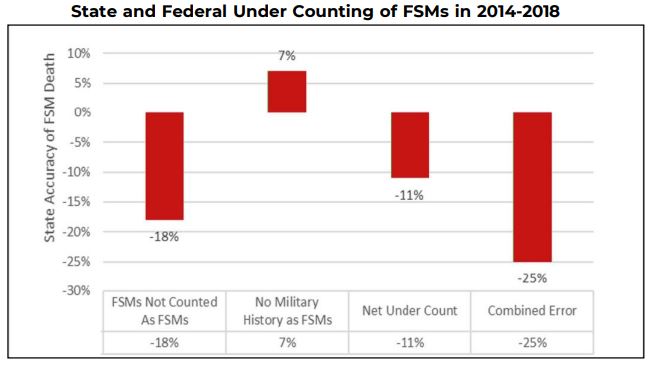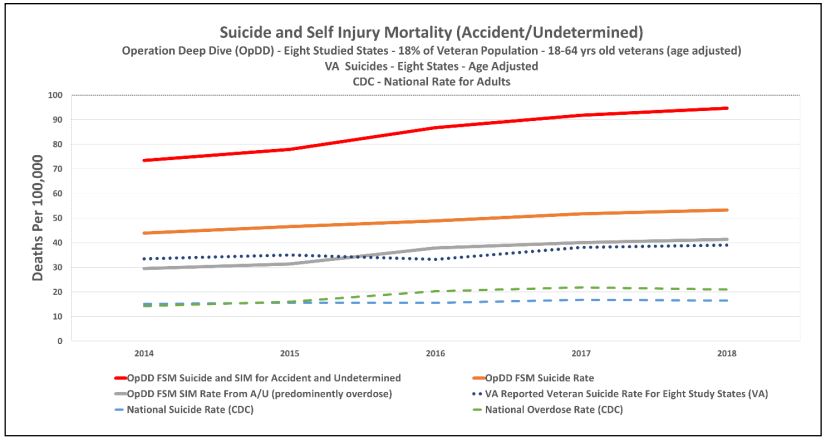Operation Deep Dive Posited Daily Suicide Rate Is 240% Higher
WASHINGTON, DC — The same week that VA announced a decrease in the national veteran suicide rate, early results from an independent study suggested that the department has been drastically undercounting the total number of veteran suicides for years.
According to the nonprofit study, a reliance on data provided by county coroners has caused VA to overlook thousands of veterans who likely died by suicide, potentially raising the daily rate by 240%.
The study’s researchers are also attempting to go far beyond death statistics in a search for underlying patterns of circumstance and behavior that might contribute to the prevention of veteran suicide in the future.
The study, Operation Deep Dive, is being run by America’s Warrior Partnership (AWP), a national nonprofit with a mission to prevent veteran suicides and is being conducted in partnership with the University of Alabama and Duke University. Researchers have been gathering state-provided death data, coordinating with DoD to corroborate military affiliation and attempting to identify patterns between the servicemember, their military service and their death.
The study looked at veterans who died by suicide in eight states between 2014 and 2018. By coordinating with DoD, they were able to receive a more accurate count of who was a former servicemember and who wasn’t. According to the study, 7% of the deceased who were counted as veterans by county coroners had no military history, while 18% of veterans were not counted at all, for a combined undercount of 11%.
Overall, researchers counted 24 veterans dying by suicide each day, a 37% increase over VA’s 17.7 per day during that time period.
The researchers also looked at self-injury mortality (SIM) deaths, which had predominantly been attributed as accidents, the vast majority of which were overdoses. An additional 20 veterans a day died by self-injury mortality. Combined with those officially coded as suicides, the daily rate could be as high as 44, 2.4 times the VA recorded average.
According to AWP representatives, the error in counting is not VA’s, but rather occurs at the local level where most death data is entered.
Researchers Call for Improvements
“Improvements are needed at the local, state, and national levels regarding death reporting,” AWP noted in its interim study report. “Data standardization and the use of ICD codes regarding suicide and SIM would improve insights. Coroners and medical examiners need better funding with standardized tools and approaches for accounting for former servicemembers’ deaths.”
The researchers also advocated that DoD and VA make available a tool for coroners and medical examiners to validate military service as part of the death record.
However, according to AWP, an accurate count of veteran suicides is only the beginning. The goal of Operation Deep Dive is to gather as much information as possible about each veteran, even reaching out to the general public to come forward and provide information about veteran friends and family who have committed suicide. By doing so, they hope to discover new patterns and subsequent prevention methods.
Analysis of Operation Deep Dive’s data has identified military service and lifestyle characteristics that highlight which former servicemembers are most at risk.
According to the researchers, the longer someone has served in the military, the lower their probability of taking their own life–decreasing 2% for every year served. Those who served for less than three years were at the greatest risk. Receiving a demotion during military service increased the odds of dying by suicide/SIM by 56%.
Veterans from the Coast Guard were most likely to die from suicide/SIM, followed by the Marine Corps, Army, Navy and Air Force.
The data also showed that living with a partner decreased the odds of suicide/SIM by nearly 40%.
Other demographics, such as race and gender, did not impact the odds, with most veteran suicides being male and white. At-risk demographics differed by community to community, with specific areas of concern dependent on how veterans were positioned and characterized in that community.
According to AWP, this further reinforces the need for multiple suicide prevention approaches that vary by locality.
“A one-size-fits-one approach is needed to prevent premature non-natural death. Former service member suicide and SIM methods of death differ significantly from state to state and from community to community,” the interim study report stated. “Prevention strategies must begin at the community level by holistically focusing on housing, meaningful employment, financial security, relationships, purpose, physical health, and mental well-being. Solely focusing on the mechanism of death does not address the root cause of suicide/SIM.”



